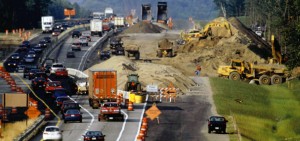
Motorists need to understand the purpose of user charges
By Corinne Lynds
Roads motorists Ontario roads traffic congestion Motorists in Ontario already pay for most road construction and maintenance costs through registration fees, and fuel and excise taxes. Despite this, commuters face chronic congestion on Ontario’s roads, which has a negative impact on our economic productivity and overall quality of life.
Motorists in Ontario already pay for most road construction and maintenance costs through registration fees, and fuel and excise taxes. Despite this, commuters face chronic congestion on Ontario’s roads, which has a negative impact on our economic productivity and overall quality of life.
As policymakers look at options intended to improve infrastructure and reduce congestion — such as increased investment in roads, highways and bridges — new ways to pay for these projects are being considered. Transportation infrastructure projects are typically large and for the long term and recent discussions at the federal and provincial levels to help direct large sums to pay for these investments is part of the solution. Road tolls or user fees are considered a mean to advance this agenda but a new Conference Board of Canada report recommends bringing clarity between proposed policy tools and policy goals.
“Additional fees and charges on drivers are considered as ways to help finance transportation infrastructure and stimulate private investment. In turn, this can reduce congestion and optimize vehicle use. To build public support, policymakers need to explain what is the best match between pricing tools and the underlying objectives,” said Louis Thériault, vice-president, public policy.
HIGHLIGHTS
- Direct charges for road users have long been proposed as a solution to traffic congestion.
- Policymakers need to explain the purpose of congestion fees and measure their effectiveness against the objective—whether it is to generate revenue, change the behaviour of motorists, or meet a fairness/equity challenge.
- Road user charges that are intended to raise revenues that could help pay for infrastructure investment and maintenance costs generate the most revenue when motorists do not change their driving patterns. User charges that seek to make the road network more efficient and less congested should be designed to influence the behaviour of drivers so that congestion is reduced.
In a 2013 report, The Conference Board of Canada found that revenues collected from light-duty vehicle users were equal to approximately 70 to 80 per cent of the costs that they impose on the road and bridge network in Ontario. Within the Greater Torontoand Hamilton Area, revenues from motorists totalled more than 100 per cent of the total road costs. This is an important finding and should inform the design of financing models including the best public/private funding mix for new transportation infrastructure projects.
Policymakers need to explain what they hope to achieve with transportation user charges. User charges intended to raise revenue have to be implemented so the behaviour of motorists does not change. In contrast, congestion charges meant to encourage the efficient use of resources and decrease congestion must influence the choices that motorists make, whether it is using alternate routes, starting their trip at a different time, or using another mode of transportation. These have implications for how we will pay for maintaining existing infrastructure and finance large scale new infrastructure projects.
In terms of fairness and equity, many believe that those who use a service should ultimately pay for it. Going forward, decision-makers need to consider the balance between adding infrastructure, the efficient use of existing infrastructure against long-term financing plans.
The report, Congestion Costs, Road Capacity and Implications for Policymakers, was commissioned by the Canadian Automobile Association South Central Ontario (CAASCO). It is available via the Conference Board of Canada’s e-Library.




